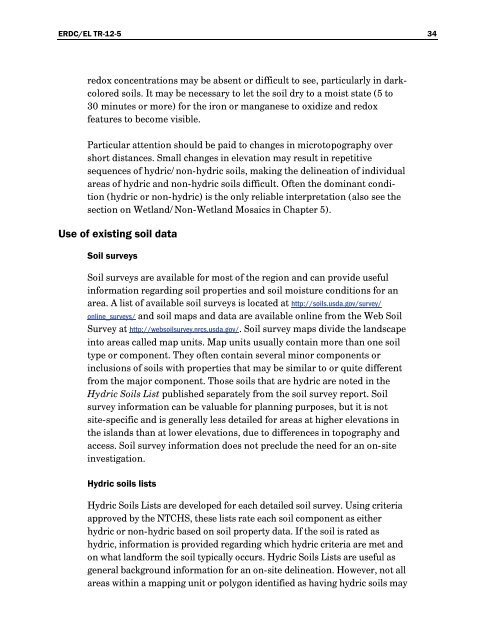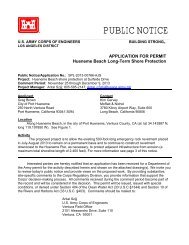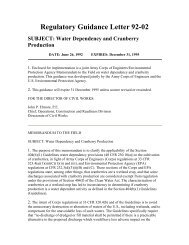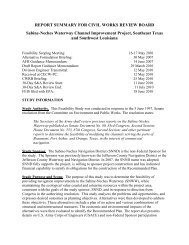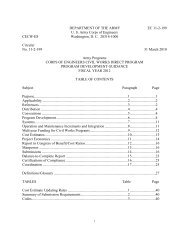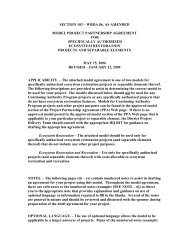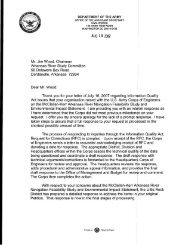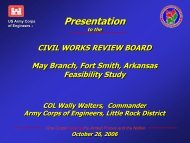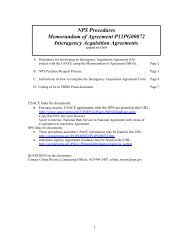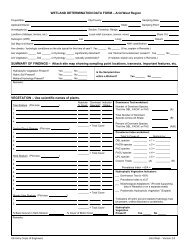Hawaii and the Pacific Islands - U.S. Army Corps of Engineers
Hawaii and the Pacific Islands - U.S. Army Corps of Engineers
Hawaii and the Pacific Islands - U.S. Army Corps of Engineers
You also want an ePaper? Increase the reach of your titles
YUMPU automatically turns print PDFs into web optimized ePapers that Google loves.
ERDC/EL TR-12-5 34redox concentrations may be absent or difficult to see, particularly in darkcoloredsoils. It may be necessary to let <strong>the</strong> soil dry to a moist state (5 to30 minutes or more) for <strong>the</strong> iron or manganese to oxidize <strong>and</strong> redoxfeatures to become visible.Particular attention should be paid to changes in microtopography overshort distances. Small changes in elevation may result in repetitivesequences <strong>of</strong> hydric/non-hydric soils, making <strong>the</strong> delineation <strong>of</strong> individualareas <strong>of</strong> hydric <strong>and</strong> non-hydric soils difficult. Often <strong>the</strong> dominant condition(hydric or non-hydric) is <strong>the</strong> only reliable interpretation (also see <strong>the</strong>section on Wetl<strong>and</strong>/Non-Wetl<strong>and</strong> Mosaics in Chapter 5).Use <strong>of</strong> existing soil dataSoil surveysSoil surveys are available for most <strong>of</strong> <strong>the</strong> region <strong>and</strong> can provide usefulinformation regarding soil properties <strong>and</strong> soil moisture conditions for anarea. A list <strong>of</strong> available soil surveys is located at http://soils.usda.gov/survey/online_surveys/ <strong>and</strong> soil maps <strong>and</strong> data are available online from <strong>the</strong> Web SoilSurvey at http://websoilsurvey.nrcs.usda.gov/. Soil survey maps divide <strong>the</strong> l<strong>and</strong>scapeinto areas called map units. Map units usually contain more than one soiltype or component. They <strong>of</strong>ten contain several minor components orinclusions <strong>of</strong> soils with properties that may be similar to or quite differentfrom <strong>the</strong> major component. Those soils that are hydric are noted in <strong>the</strong>Hydric Soils List published separately from <strong>the</strong> soil survey report. Soilsurvey information can be valuable for planning purposes, but it is notsite-specific <strong>and</strong> is generally less detailed for areas at higher elevations in<strong>the</strong> isl<strong>and</strong>s than at lower elevations, due to differences in topography <strong>and</strong>access. Soil survey information does not preclude <strong>the</strong> need for an on-siteinvestigation.Hydric soils listsHydric Soils Lists are developed for each detailed soil survey. Using criteriaapproved by <strong>the</strong> NTCHS, <strong>the</strong>se lists rate each soil component as ei<strong>the</strong>rhydric or non-hydric based on soil property data. If <strong>the</strong> soil is rated ashydric, information is provided regarding which hydric criteria are met <strong>and</strong>on what l<strong>and</strong>form <strong>the</strong> soil typically occurs. Hydric Soils Lists are useful asgeneral background information for an on-site delineation. However, not allareas within a mapping unit or polygon identified as having hydric soils may


